| Author |
Message |
|
Tony Brass
|
 Posted: Fri 28 Aug, 2009 9:34 am Post subject: Secondary Bevel Posted: Fri 28 Aug, 2009 9:34 am Post subject: Secondary Bevel |
 |
|
I often see blades criticized on this forum, if they have a secondary bevel. I know that a secondary bevel is not histrorically accurate, but, as I understand it, a blade with a secondary bevel may actually be MORE durable, than a historically accurate counterpart.
What are the plusses and minuses of a secondary bevel?
|
|
  |
 |
Nathan Robinson
myArmoury Admin


|
|
    |
 |
Maurizio D'Angelo

|
 Posted: Fri 28 Aug, 2009 12:21 pm Post subject: Posted: Fri 28 Aug, 2009 12:21 pm Post subject: |
 |
|
There are many swords that have a secondary bevel, are undoubtedly historical. It is not always possible to determine whether they were originally like this or have become so with sharpening later. Sometimes we can only assume, their timing can help us to understand what way they had originally. Sometimes this is obvious and certain, sometimes it is less clear. In the vast majority of cases, I think, but I can make mistakes, we are fine as they are received, in other cases, but it's just personal, you can search from their original form. Clearly, not always possible. is also clear that swords that have a secondary bevel, could be so already as original profile. I hope that even if a word is not translated well, the meaning is clear.
Ciao
Maurizio
Last edited by Maurizio D'Angelo on Fri 28 Aug, 2009 12:29 pm; edited 1 time in total
|
|
   |
 |
|
Anders Backlund
|
 Posted: Fri 28 Aug, 2009 12:24 pm Post subject: Posted: Fri 28 Aug, 2009 12:24 pm Post subject: |
 |
|
I've been wondering about secondary bevels as well, actually, so I'm glad this came up. Do this type of edge have any practical disadvantages that makes them undesirable?
The sword is an ode to the strife of mankind.
"This doesn't look easy... but I bet it is!"
-Homer Simpson.
|
|
  |
 |
Bryce Felperin

Location: San Jose, CA Joined: 16 Feb 2006
Posts: 552
|
 Posted: Fri 28 Aug, 2009 1:54 pm Post subject: Posted: Fri 28 Aug, 2009 1:54 pm Post subject: |
 |
|
| Anders Backlund wrote: | | I've been wondering about secondary bevels as well, actually, so I'm glad this came up. Do this type of edge have any practical disadvantages that makes them undesirable? |
Having a sword with a secondary bevel, I can say it has one great advantage...it's easy to sharpen with almost any sharpening system or stone. From what I have read and seen an appleseed edge is better, but it takes more care to create a good edge. If you're a typical soldier in the medieval period, and don't have access to a good grinding wheel or knowledge of how to sharpen a sword well, then I think having a seconary bevel edge would be easier to maintain.
Just my opinion though.
|
|
  |
 |
Jean Thibodeau

|
 Posted: Fri 28 Aug, 2009 9:36 pm Post subject: Posted: Fri 28 Aug, 2009 9:36 pm Post subject: |
 |
|
| Bryce Felperin wrote: | | Anders Backlund wrote: | | I've been wondering about secondary bevels as well, actually, so I'm glad this came up. Do this type of edge have any practical disadvantages that makes them undesirable? |
Having a sword with a secondary bevel, I can say it has one great advantage...it's easy to sharpen with almost any sharpening system or stone. From what I have read and seen an appleseed edge is better, but it takes more care to create a good edge. If you're a typical soldier in the medieval period, and don't have access to a good grinding wheel or knowledge of how to sharpen a sword well, then I think having a secondary bevel edge would be easier to maintain.
Just my opinion though. |
When resharpening lightly an appleseed edge one may create a very small secondary bevel and to get back to a true apple seed shouldn't be too difficult by varying the angle of the stone and burnishing the edge.
If removing some deep notches then maybe getting a good looking appleseed edge might take some real work and real skill.
On a practical level a small secondary bevel probably doesn't make as big difference in cutting ability of the edge.
You can easily give up your freedom. You have to fight hard to get it back!
|
|
  |
 |
Jared Smith

|
 Posted: Fri 28 Aug, 2009 9:59 pm Post subject: Re: Secondary Bevel Posted: Fri 28 Aug, 2009 9:59 pm Post subject: Re: Secondary Bevel |
 |
|
| Tony Brass wrote: | as I understand it, a blade with a secondary bevel may actually be MORE durable, than a historically accurate counterpart.
What are the plusses and minuses of a secondary bevel? |
Many modern knifes actually have a small secondary and very small tertiary bevel (usually closer than 1 mm to the actual cutting edge for knifes.) It allows one to resharpen it more times before grinding into the overall blade angle and having to remove a greater amount of material, loss of dimension to deal with small dull spots or very minor nicks.
On the minus side, I have found it harder to get "shaving" sharpness (easily slices leather with low pressure) with these types of edges. However, that is really not what heavier utility blades and swords are meant for in my opinion. So, I wouldn't call it a minus for something not intended for scalpel type work.
Absence of evidence is not necessarily evidence of absence!
|
|
  |
 |
Julien M

|
 Posted: Sat 29 Aug, 2009 2:44 am Post subject: Posted: Sat 29 Aug, 2009 2:44 am Post subject: |
 |
|
| Nathan Robinson wrote: | | Historical swords can be found with secondary bevels and without and with all kinds of other geometries. The automatic critique of this feature as being non-historical is simply wrong. |
This has been stated by you and others a few times on this forum already. Would you or anyone have pictures of museum examples featuring a secondary beveled blade? I can't recall spotting one in any museum I've been. I'm having a custom sword made, and by the default sharpening will feature a bevel and I am concerned by that...
Cheers,
J
|
|
  |
 |
Nathan Robinson
myArmoury Admin


|
 Posted: Sat 29 Aug, 2009 2:45 am Post subject: Posted: Sat 29 Aug, 2009 2:45 am Post subject: |
 |
|
| Julien M wrote: | | This has been stated by you and others a few times on this forum already. Would you or anyone have pictures of museum examples featuring a secondary beveled blade? I can't recall spotting one in any museum I've been. I'm having a custom sword made, and by the default sharpening will feature a bevel and I am concerned by that... |
You're in London... take a trip to the Wallace Collection. When I was there, I took note of several swords having different edge geometries. It was an eye opener to me.
.:. Visit my Collection Gallery :: View my Reading List :: View my Wish List :: See Pages I Like :: Find me on Facebook .:.
|
|
    |
 |
Julien M

|
 Posted: Sat 29 Aug, 2009 3:05 am Post subject: Posted: Sat 29 Aug, 2009 3:05 am Post subject: |
 |
|
Hi Nathan,
I go there once every two month or so. Well I confess my attention must have been drawn to more obvious features such as hilts parts or even other artifacts like that stunning mounted gothic armor 
I'll also make the trip to the royal armouries in Leeds in a couple of weeks, the musee de Cluny and the musee de l'armee in Paris later on this month. I'll pay special attention to this and will grab picts whenever I'll be able to do so.
If anyone needs pics of a specific sword/armor let me know (save for the Wallace were pics are not allowed).
Cheers,
J
|
|
  |
 |
Maurizio D'Angelo

|
 Posted: Sat 29 Aug, 2009 5:49 am Post subject: Posted: Sat 29 Aug, 2009 5:49 am Post subject: |
 |
|
| Julien M wrote: |
I'll also make the trip to the royal armouries in Leeds in a couple of weeks, the musee de Cluny and the musee de l'armee in Paris later on this month.
If anyone needs pics of a specific sword/armor let me know (save for the Wallace were pics are not allowed).
|
Hi, Julien,
Royal Armories in Leeds. I believe and hope that you find in this museum. 
The two swords are these. Among other things it is very clear on a secondary bevels.
Some photos, detailed in the section and pommel, will be much appreciated.
Many thanks in advance
Ciao Julien
Maurizio
 Attachment: 28.75 KB Attachment: 28.75 KB

 Attachment: 47.89 KB Attachment: 47.89 KB

|
|
   |
 |
Julien M

|
 Posted: Sat 29 Aug, 2009 6:15 am Post subject: Posted: Sat 29 Aug, 2009 6:15 am Post subject: |
 |
|
HI Maurizio,
No problem, will do a couple of close shots if I can.
Cheers,
J
|
|
  |
 |
Maurizio D'Angelo

|
 Posted: Sat 29 Aug, 2009 6:38 am Post subject: Re: Secondary Bevel Posted: Sat 29 Aug, 2009 6:38 am Post subject: Re: Secondary Bevel |
 |
|
| Tony Brass wrote: | I often see blades criticized on this forum, if they have a secondary bevel. I know that a secondary bevel is not histrorically accurate, but, as I understand it, a blade with a secondary bevel may actually be MORE durable, than a historically accurate counterpart.
What are the plusses and minuses of a secondary bevel? |
Hi all,
The speech I want to do is purely technical, not historical.
I have two blades.
Both must have: equal thickness maximum, equal length, equal width, equal taper, equal fuller.
If a lenticular is will have: more resistance, more weight, less performant (I think all'handling)
Should also be considered that the mechanical large radius, mean more resistance, I'm saying, a speech complex, using a lot of synthesis of thought.
If a diamond is will have: less resistance, less weight, more performance. (I think all'handling)
If the difference is only in the secondary bevels, the difference exists but is negligible.
Ciao, maurizio
|
|
   |
 |
Jared Smith

|
 Posted: Sat 29 Aug, 2009 7:26 am Post subject: Re: Secondary Bevel Posted: Sat 29 Aug, 2009 7:26 am Post subject: Re: Secondary Bevel |
 |
|
| Maurizio D'Angelo wrote: | [
If the difference is only in the secondary bevels, the difference exists but is negligible.
Ciao, maurizio |
You could achieve that. (Possibly many of us would just do it accidentally in resharpening a practice cutter versus an identical model sword kept for display only. Slight changes in width would develop, but not really be that noticeable.)
However, the secondary bevel resulting above would probably be less pronounced than normal for a blade carefully designed to have a secondary bevel for purpose of strength and durability. I would expect it to be thicker, and possibly narrower if handling were to be kept identical. A secondary bevel design generally has a thicker blade just behind the cutting edge, which gives the overall blade more strength, and to some degree helps the edge to resist curling and chipping (as in axes with the apple seed or sometimes 2/3 bevel angle changes near the cutting edge.) You can also see this on some thin pocket knife blades and disposable razor blades which would be too thin/ weak if edges tapered gradually the whole way. Instead, almost no blade taper exists on these, and a small secondary bevel alone provides the cutting edge.
Absence of evidence is not necessarily evidence of absence!
|
|
  |
 |
|
Peter Johnsson
Industry Professional
|
 Posted: Sat 29 Aug, 2009 8:30 am Post subject: Posted: Sat 29 Aug, 2009 8:30 am Post subject: |
 |
|
The two swords shown in this thread are not good examples of secondary bevels in the meaning of the question of the topic. These are swords with clear examples of hexagonal and octagonal cross section: intended and dedicated design features.
What you see as the defined edge is just that: the edge, not a shape resulting from re sharpening.
A secondary bevel as discussed here: a result of re sharpening or establishing of sharpness on a blade with a certain geometry (lenticular, diamond or whatever), is something that occurs in a much smaller scale: we are talking about a millimeter or less.
When the edge bevel forms a significant part of the geometry it is a different matter entirely. The two cannot compare as they come into being from different reasons.
Both of these swords shown above *can* in fact have secondary bevels, but you would never be able to see that in such grainy photos.
I have actually documented one of them (the XVIa. 5: the lower of the two) and can testify it does not have a secondary bevel. It has an octagonal cross section with fairly narrow but clearly defined edge bevels. The geometry of the edge is an elegant apple seed section with very slightly swelling sides. The face of the edge bevel grows gradually directly into the sharpness of the edge: just like the famous japanese swords are sharpened (and with a very similar edge angle as well).
It is in fact a smaller sibling to the Brescia spadona that was discussed a few weeks ago relating to the very same question of how to correctly describe cross sectional geometry.
I can accept that a secondary bevel could be defined as something that these two swords exemplifies, but then it is something that will never occur as a result of wear and re sharpening.
It is not a very good choice of terminology, however. To define a secondary bevel thus would be very confusing and quite contrary to popular use of the word: a very narrow bevel that is formed as result of final sharpening of a blade.
If you have a blade that is almost sharp, or one that has just lost its bite, you can put it to a stone or coarse hone and re establish the sharpness. While doing this you can strive to blend the new surface into the general geometry and so establish an apple seed edge, or you can leave it as a defined crisp and narrow bevel: a secondary bevel.
When we look at swords with a more complex cross sectional geometry than simple lenticular or diamond, we need to keep in mind the scale of things: the bevels and facets we see in photos of swords are often between 6 and 15 millimeter wide. This kind of surface and plane is not the result of restoration of the edge as part of the life and use of the sword: it s an intended feature of the blade established by the blade smith and blade grinder. These elements are part of the design of the cross section.
Such a blade could have a secondary bevel forming the sharpness of the edge, but the strength and sharpness of it would not depend on wether it was a secondary bevel, or a blended apple seed edge.
I do not think it helps our understanding if we confuse these design concepts by describing them as secondary bevels.
The merit and quality of the edge (or the lack thereof), is a result of the thickness behind the edge, the hardness of the steel, the grain size of the steel, and the total angle of the sharpness.
A secondary edge could be very delicate and fine, a scalpel or razor knife edge, if formed on a very thin blade with an extremely low angle of the overall geometry, or it could be a very crude and blunt wedge ground into a thick bar of a blade. Likewise can a blended apple seed edge be both very fine and quite blunt.
It is all a question of angles and blending and the nature of the overall geometry of the blade.
|
|
   |
 |
Glen A Cleeton

|
 Posted: Sat 29 Aug, 2009 12:16 pm Post subject: Posted: Sat 29 Aug, 2009 12:16 pm Post subject: |
 |
|
Thank you Peter,
I have to just shrug and read on in some threads like these but you have done well to wrap up what is often just perception and not the realities of a visual presentation. I am going to attach a couple of pictures below that should show that as well. In one picture, the secondary grind (can we agree it is a grind ?8^) ) and in the other a long shot of a blade that can almost capture that an apparently quite flat secondary is actually the change in crossection itself. The main part of the blade body is slightly hollow ground, with the base of the edge then swelling to support what becomes quite a fine edge and even visually there, the rounding of that (or in other cases a blending some will call rolled).
I can't say I have entirely given up in trying to explain what you have offered above but it seems no matter how clearly the pictures (realities) can be described, the rallying cry of edge horror seems to muddy the truths still more. Gus tried once in explaining the visual perception on many swords is simply a difference in polish and that if those were polished longwise to match the rest, they are less apparent. Others read that and will then maintain "well then. that's not a secondary bevel"  No, no, that's a rolled edge is not. Is too. Is not. But why? No, no, that's a rolled edge is not. Is too. Is not. But why? 
Cheers
GC
|
|
  |
 |
|
Peter Johnsson
Industry Professional
|
 Posted: Sat 29 Aug, 2009 1:03 pm Post subject: Posted: Sat 29 Aug, 2009 1:03 pm Post subject: |
 |
|
Here follows some real life examples, just to illustrate how bevels and sharpening can look.
 Attachment: 73.76 KB Attachment: 73.76 KB
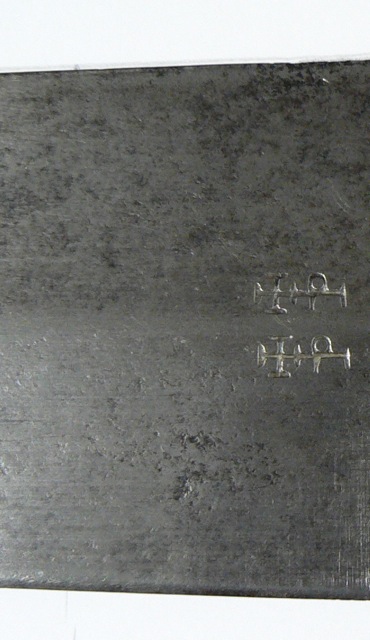
An example where a narrow secondary bevel is used to put sharpness on a blade with wide, thin and slightly hollow ground section. Very little has been done to blend the sharpening bevel into the main geometry of the blade.
 Attachment: 90.24 KB Attachment: 90.24 KB
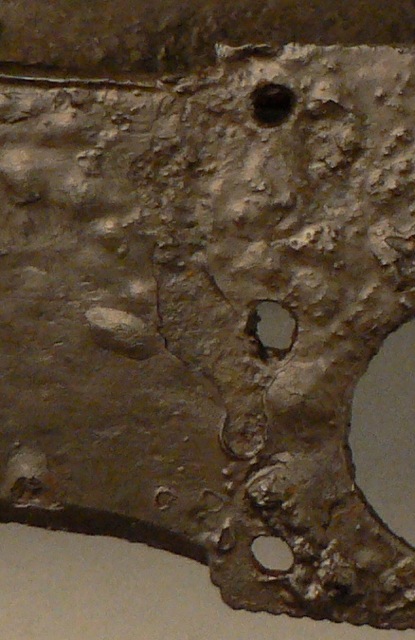
A single edged Germanic blade that has very clearly been re sharpened quite a few times during its time of use: the blade has become noticeably narrowed. The secondary bevel formed from sharpening is left without blending.
 Attachment: 69.84 KB Attachment: 69.84 KB
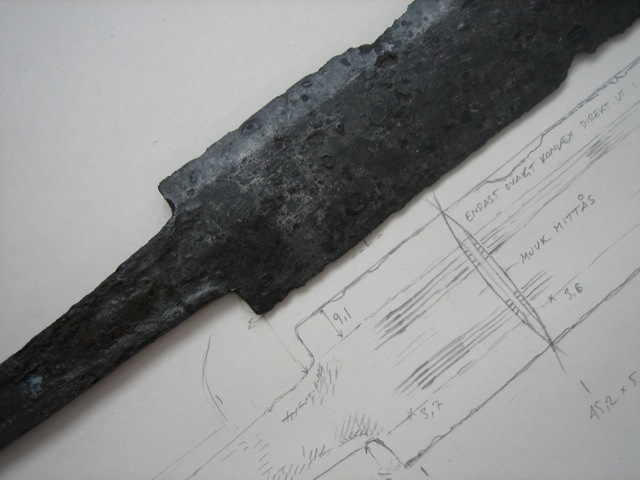
An example of a Roman blade in very good state of preservation. It might have been described as lenticular but is in fact octagonal in section. The edge is an elegant apple seed section.
 Attachment: 46.75 KB Attachment: 46.75 KB
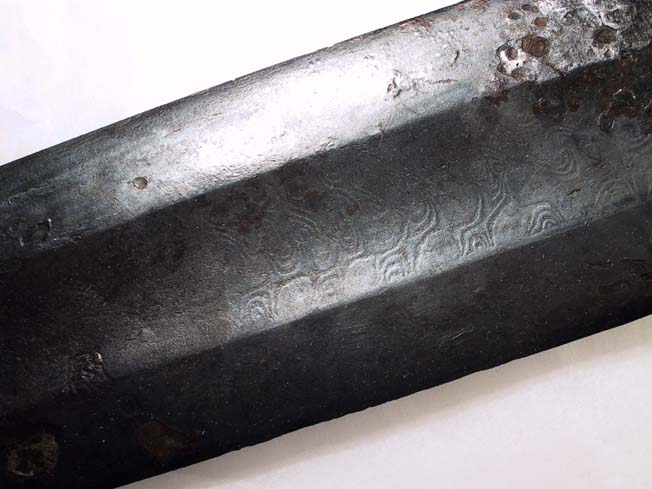
A viking sword with unusually well preserved surface: note how the edge bevels grow gradually into the sharpness without any sign of any secondary bevel: the norm of edge geometry in western tradition.
 Attachment: 36.22 KB Attachment: 36.22 KB
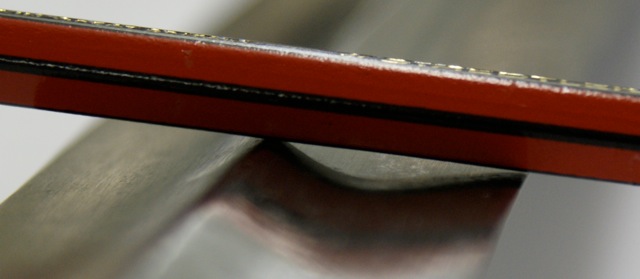
A type XVIII: perhaps you can see how the sharpness is gradually blended into the main hollow bevel within the last 2 mm or so.
|
|
   |
 |
|
Tony Brass
|
 Posted: Sat 29 Aug, 2009 10:23 pm Post subject: Posted: Sat 29 Aug, 2009 10:23 pm Post subject: |
 |
|
Peter,
Thank you very much. You are defining my question correctly. This has refined the terms in my mind. So now I ask, if a non-swordsmith soldier is re-sharpening his blade, I would imagine that he would be creating that axe-like secondary bevel that is not an intended function of the edge geometry: Is that new axe-like edge weaker? more durable? not as sharp?
Why is is so much less desirable? Is it eating away at the material too fast, or is this just a question of aesthetics?
|
|
  |
 |
Maurizio D'Angelo

|
 Posted: Sat 29 Aug, 2009 10:24 pm Post subject: Posted: Sat 29 Aug, 2009 10:24 pm Post subject: |
 |
|
Hi Peter,
Here, I'm famous for my academic English.  school grades: in Italian 8, in German 7, in English 4, school grades: in Italian 8, in German 7, in English 4,  ) )
Joking aside.
1) Thanks for your post. It's of great help.
2) If I understand correctly. In English secondary bevel mean a sharpening of about 1 mm. It serves to make the cut.
3) in the sense given this topic by Mr Tony Brass is with this meaning.
4) in an octagonal section, for example, the XVIa. 5: is the smaller brother of the Spadona in Brescia (the lower of the two my pictures) the bevel are part of the section, no sharpening.
5) I know well that you are a great hoplology, the best maybe, but just out of curiosity, do you know other hoplology or other reliable texts that speak of octagonal section? This is said with great respect.
6) You write: <<I can accept that a secondary bevel could be defined as something that exemplifies these two swords, but then it is something that will never occur as a result of wear and re sharpening.
It is not a very good choice of terminology, however. To define a secondary bevel Thus would be very confusing and quite contrary to popular use of the word: A very narrow bevel that is formed as result of final sharpening of a blade.>>
I understand that is a problem of correct terminology.
7) Here, in the XVI spothlight, http://www.myArmoury.com/review_alb_brescia.html ,right on Brescia Spadona it is written: <<Albion Cutler's head Eric McHugh commented on the blade's design, "There is a small but noticeable Brescia secondary bevels on the blade. It is a wide secondary bevels, too. So this is what you are seeing. This is one of the features of the original. In photos of the original, you can just make it out when the light plays on the blade, but that is the hint that it is there. " The blade also exhibits a cleanly executed narrow fuller that runs nearly half the blade length. At the Fuller's end, the blade transitions into a shallow diamond cross-section. This cross-section combines with the secondary bevels at the tip, Which results in a point that is properly reinforced for use against armored targets.>>
Again it is written: <<Collector Chad Arnow was impressed with the Brescia's blade and commented, "The blade is cleanly finished, especially given its complexity. Fullered The visible portion of the blade has secondary bevels like the original, Which gives that part of the blade hexagonal cross-section. As the fuller terminates at midrib appears, giving the rest of the blade eight distinct planes or faces. All the lines delineating these features are crisp without looking artificial or modern.>> I think that the "hexagonal" is only a copying error.
8) I put those two pictures, saying they were a clear example of secondary bevel for what I read.
9) I 'am not a native language, I make much effort to write well and to understand the meaning of words. I am, a little bit, confused, now.
10) if everyone agrees on the significance of secondary bevel, and no one suggests different things, I fixed this as a rule indicating the sections.
Ciao
Maurizio
Last edited by Maurizio D'Angelo on Sat 29 Aug, 2009 11:12 pm; edited 2 times in total
|
|
   |
 |
Maurizio D'Angelo

|
 Posted: Sat 29 Aug, 2009 10:38 pm Post subject: Re: Secondary Bevel Posted: Sat 29 Aug, 2009 10:38 pm Post subject: Re: Secondary Bevel |
 |
|
Hi Tony,
| Tony Brass wrote: | I often see blades criticized on this forum, if they have a secondary bevel. I know that a secondary bevel is not histrorically accurate, but, as I understand it, a blade with a secondary bevel may actually be MORE durable, than a historically accurate counterpart.
What are the plusses and minuses of a secondary bevel? |
Can you explain where you've read this, in this forum?
Ciao
Maurizio
|
|
   |
 |
|
|
You cannot post new topics in this forum
You cannot reply to topics in this forum
You cannot edit your posts in this forum
You cannot delete your posts in this forum
You cannot vote in polls in this forum
You cannot attach files in this forum
You can download files in this forum
|
All contents © Copyright 2003-2025 myArmoury.com — All rights reserved
Discussion forums powered by phpBB © The phpBB Group
Switch to the Basic Low-bandwidth Version of the forum
|

